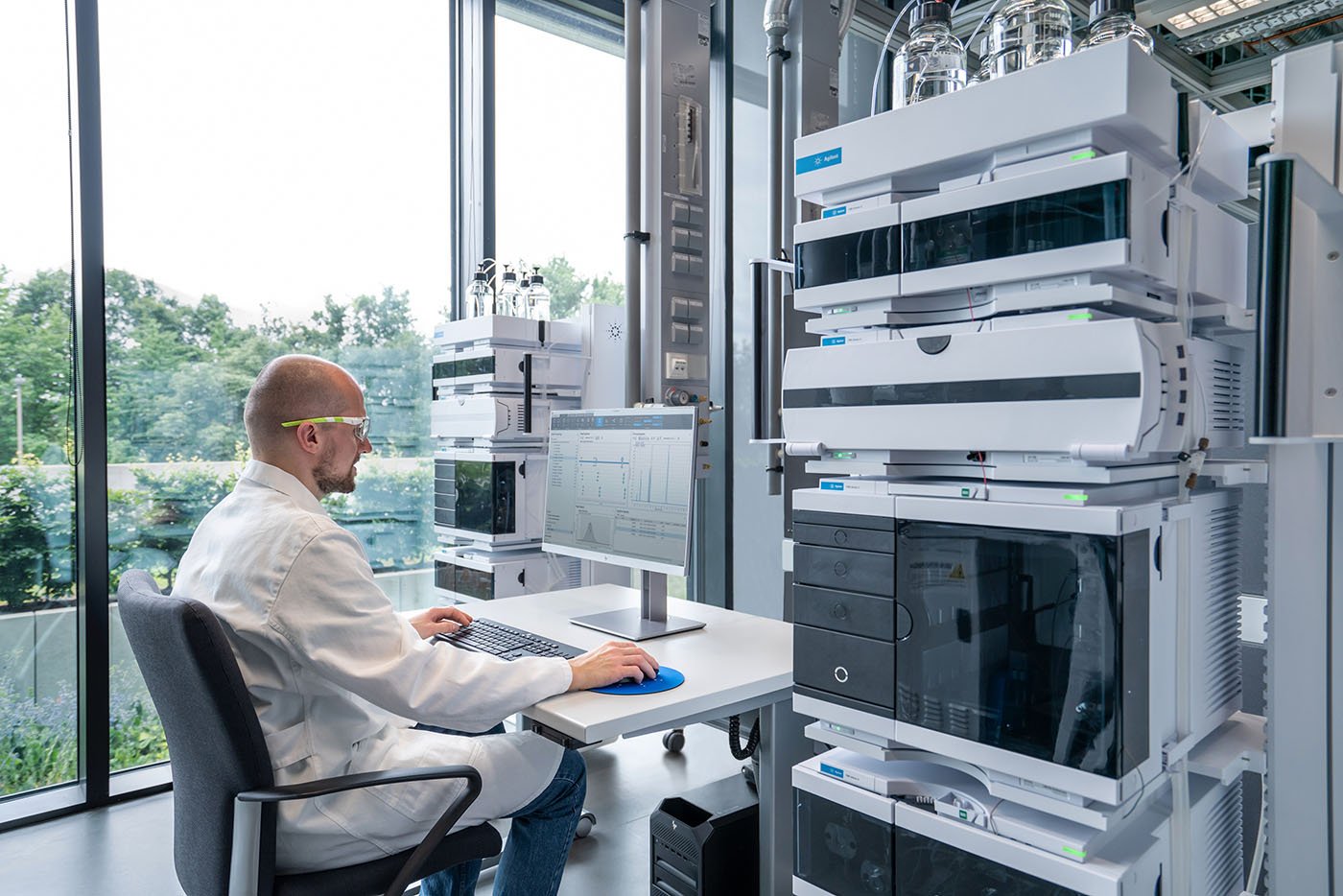To identify specific chemicals or molecules in the life sciences and medical research, scientists often use mass spectrometry (MS), usually paired with liquid chromatography (LC). These technologies continue to improve in accuracy, sensitivity, and throughput. One of the most important trends in MS is how this technology is being used in more fields, a result of these technology improvements or from collaborations and partnerships. To explore some of the most interesting advances in MS, GEN talked with experts from several leading companies.
Adding up the omics
Two years ago, Thermo Fisher Scientific introduced the Thermo Scientific Orbitrap Astral MS, and it’s already been used in more than 320 research articles. “That’s incredible adoption,” says Aaron Robitaille, PhD, a life sciences researcher and director of marketing for mass spectrometry at Thermo Fisher. “This is truly the acceleration of science, and it’s been over a wide application space, from fundamental biology through disease applications.”

Then, at the 2025 American Society for Mass Spectrometry conference in Baltimore, Thermo Fisher launched its next-generation instrument called the Thermo Scientific Orbitrap Astral Zoom MS. According to Robitaille, this instrument “is really powerful for proteomics, but also now in expanded application areas for small molecules like metabolomics, lipidomics, and exposomics,” the latter of which explores how environmental exposures, such as pesticides in foods, impact biological processes like metabolism. In addition to the Orbitrap Astral Zoom’s expanded applications, it provides 35% faster scanning, 40% higher throughput, and 50% more multiplexing than its predecessor. This new model gives scientists “increased flexibility for more applications while providing accurate and precise quantitation,” Robitaille explains.
To achieve these improvements, Thermo Fisher optimized a collection of components. For example, a faster ion processor increased the scan rate from 200 to 270 hertz. Consequently, one scientist studying lung cancer in nonsmokers reduced the time needed to analyze samples from 6,000 patients from 1,000 to 100 days.
Although speed is important, so is sensitivity, especially consistent sensitivity. According to a study by scientists at the University of Washington and Thermo Fisher, both the Orbitrap Astral and Astral Zoom produce a median coefficient of variation (CV) below 20 and 10% for peptides and proteins, respectively, and the Astral Zoom “exhibited narrower CV distributions and lower median CVs than the Orbitrap Astral MS,” Robitaille said.1 “So, it’s really about not just seeing the sample, but seeing it reproducibly, reliably, and being able to measure differences between cells.”
With such consistent sensitivity, scientists can apply MS to more questions. For example, scientists are using Thermo Fisher instruments to study per- and polyfluoroalkyl substances (PFAS), which are long-lasting chemicals that can now be found in almost any sample collected from any place in the world. According to the U.S. Environmental Protection Agency: “Scientific studies have shown that exposure to some PFAS in the environment may be linked to harmful health effects in humans and animals.”
Partnering in cancer therapy

On May 14, 2025, Agilent announced a partnership in cancer research with Ubix Therapeutics. This partnership was designed to accelerate the development and optimization of targeted protein degradation (TPD) and antibody-drug conjugates (ADCs) for cancer therapy. “By combining Ubix’s proprietary Degraducer platform with Agilent’s advanced analytical technologies, including LC/MS systems, the InfinityLab Bio LC portfolio, and BioTek instruments, the collaboration aims to create efficient, scalable workflows for drug development,” says You Jae Soo, Agilent Korea general manager and associate vice president of sales. “A central objective is to advance precision oncology by enabling the targeting of previously undruggable proteins through the ubiquitin-proteasome pathway, or UPP, ultimately leading to safer and more effective therapies.”
MS will play a central analytical role in this partnership. “For ADCs and TPD molecules, high-resolution LC-MS/MS will be employed to assess drug-to-antibody ratios, as well as conjugation sites and payload stability,” says Soo. For TPD molecules, high-resolution LC-MS/MS will also be used for impurity profiling, enabling the detection and characterization of low-abundance impurities and degradation products that could affect therapeutic efficacy or safety. “To manage the complexity of these samples and improve separation efficiency, the use of 2D-LC will be essential—providing enhanced peak capacity and resolving power, particularly when dealing with highly complex TPD mixtures or co-eluting species,” Soo says.
This partnership will use MS to characterize intact proteins and conjugates. “In quantitative proteomics, techniques such as label-free quantification or isobaric tagging using Q-TOF systems will facilitate precise measurement of protein degradation and target engagement,” Soo says. “Targeted proteomics using triple quadrupole instruments will support biomarker discovery and validation, essential for patient stratification and monitoring therapeutic efficacy.” Plus, LC-QTOF or LC-Orbitrap platforms will be used to investigate metabolic pathways, drug metabolism, and pharmacokinetics.
These technologies promise to improve both analytical methods and workflows to advance targeted cancer therapy and immuno-oncology research. “By increasing throughput and reproducibility through platforms like the InfinityLab Bio LC and automated sample preparation systems, researchers can streamline complex analyses and reduce variability,” Soo says. “The high sensitivity and specificity of Agilent’s mass spectrometry systems enable the detection of low-abundance targets, which is crucial for early-stage profiling of TPD and ADC candidates.”
High-sensitivity protein analysis
In many cases, MS is improved to address key objectives. For example, Morty Razavi, PhD, CEO at SISCAPA Assay Technologies, says, “There remains an unmet need in proteomics for a single coherent platform that delivers sensitivity, specificity, and throughput from exploratory studies on many proteins to robust clinical measurement of selected targets.”
So, SISCAPA is collaborating with Biognosys. “SISCAPA offers ultra-specific, high-sensitivity, and calibratable protein measurements through its proprietary assay menu and automation-ready workflow built for high-throughput applications,” Razavi says. “Biognosys complements SISCAPA with state-of-the-art discovery proteomics, leveraging ultra-sensitive, mass spectrometry-based workflows known for their exceptional depth and data quality.” In combination, he says this collaboration “forms an end-to-end solution that enables pharma partners to move seamlessly from biomarker discovery to the development of validated, super-sensitive targeted assays—supporting clinical trials and ultimately companion diagnostics within a unified, scalable framework.”
Although thousands of potential protein biomarkers have been identified over the past two decades, approval of them by the U.S. Food and Drug Administration has stalled at an average of two to five per year over the past 30 years. “This highlights a critical bottleneck in the field: the inability to efficiently translate discovery findings into validated, deployable clinical assays,” Razavi says.
To address this bottleneck, SISCAPA’s technology selectively enriches protein-specific target peptides from complex digested biological matrices—such as blood, serum, or plasma—using proprietary high-affinity antibody binders. “This targeted enrichment effectively eliminates non-specific background, delivering highly purified peptides—alongside their stable isotope-labeled internal standards—directly to a mass spectrometer,” Razavi says. By concentrating the peptides and removing background, proteins can be detected at sub-picogram per milliliter levels. As Razavi notes, “When paired with the ultra-sensitive mass spectrometry workflows pioneered by Biognosys, this integrated approach delivers exceptional sensitivity in proteomics, without compromising specificity, precision, or throughput.”
Optimum and faster peptide mapping
To directly confirm the sequence and post-translational modifications (PTMs) of a biotherapeutic, as well as monitor product and critical quality attributes (PQAs and CQAs, respectively), scientists use peptide mapping (PMAP). This technique supports the characterization of monoclonal antibodies (mAbs) and new molecular formats (NMFs), which usually present higher complexity and proportionally intricate characterization requirements from regulatory agencies. “One of the key challenges is that PMAP is a generally low-throughput method and involves complex data curation,” says Karina Bora, PhD, global senior technical lead of integrated biologics at Lonza. “This is especially relevant in early process development, which relies on high-throughput screening of a high number of conditions to support cell-clone selection and process optimization.”
To tackle this, Lonza developed high-throughput, multi-attribute monitoring (MAM) PMAP workflows for targeted PTM analysis. “These workflows include shorter LC analysis designed to detect critical PTMs, optimized MS-acquisition settings to have a duty cycle suitable for quantitation of the resulting chromatographic peaks, and faster data-curation using a combination of traditional MS data-processing software and R programming,” Bora explains.
Plus, “The success of PMAP is heavily dependent on the first protein-digestion step, in which the protein is broken down into peptides,” Bora says. Typically, trypsin is the golden standard protease for PMAP analysis, “but it can be unsuitable for some NMFs, such as highly glycosylated Fc-fusion proteins, with the primary sequence inaccessible to trypsin or requiring a tailored digestion approach to achieve sequence coverage and PTM quantitation.”
To address this, Lonza scientists developed a toolbox of protease digestion protocols to support efficient and product-specific digestion conditions for NMFs. “This was achieved by screening a number of alternative proteases that digest proteins at different sites and can have a broad or strict specificity, which impacts the digestion efficiency and suitability for sequence coverage and/or PTM characterization,” says Francesca Ferlenghi, PhD, associate principal scientist of integrated biologics at Lonza.
With Lonza’s processes and tools, scientists can apply PMAP for high-throughput analysis of targeted PTMs in early-stage development, “which can be crucial for certain NMFs that require tracking of challenging CQAs and cannot rely solely on titer and other basic product-quality analysis during cell-line and process optimization,” Ferlenghi says.
Overall, recent advances in MS make this technology fit-for-purpose in an increasing number of applications. The right fit, though, increasingly depends on improved LC and MS, as well as other tools and techniques, and perhaps even the right collaborators.
Reference
- Hsu C, Shulman N, Stewart H, et al. Evaluation of an Orbitrap Astral Zoom mass spectrometer prototype for quantitative proteomics – Beyond identification lists. bioRxiv. Preprint posted online May 31, 2025.
The post Mass Spectrometry for the Masses appeared first on GEN – Genetic Engineering and Biotechnology News.




